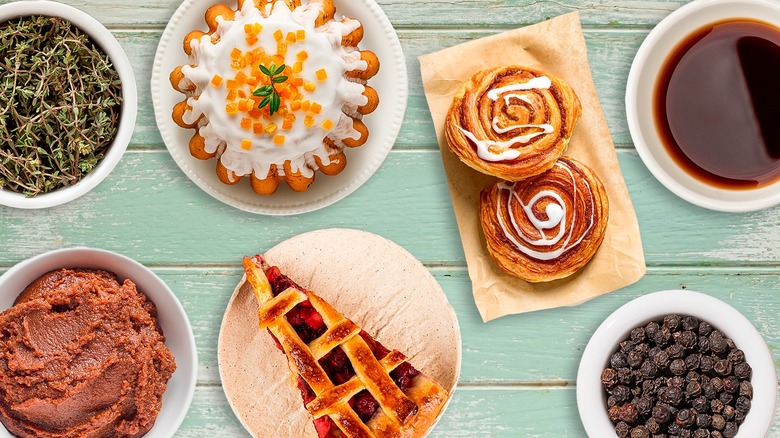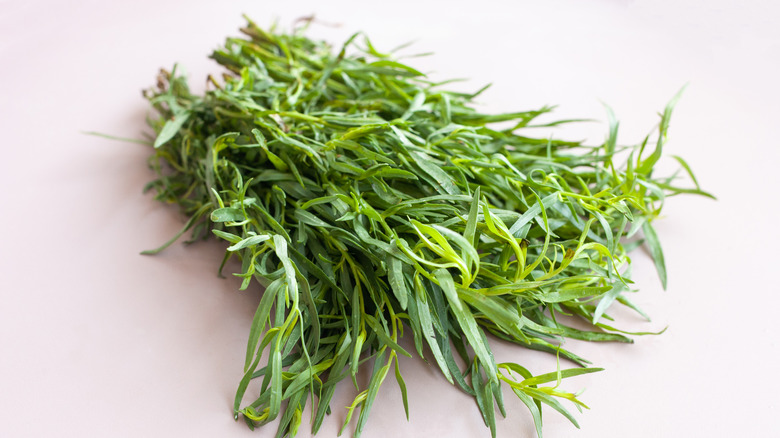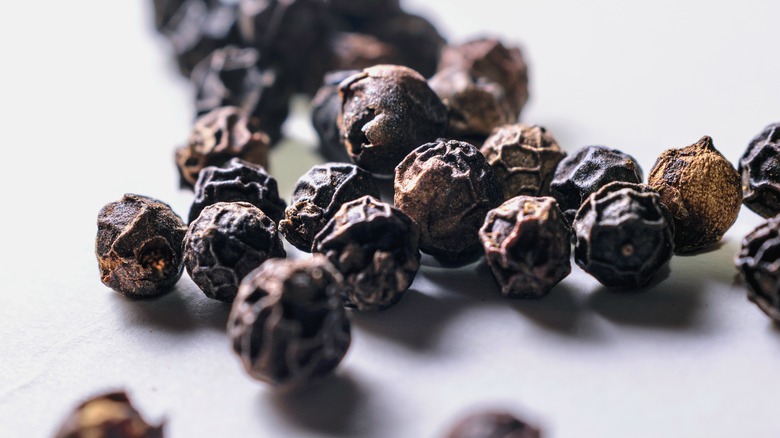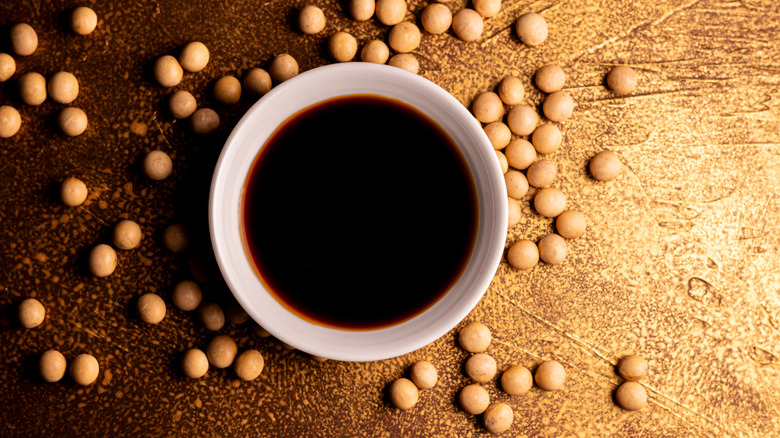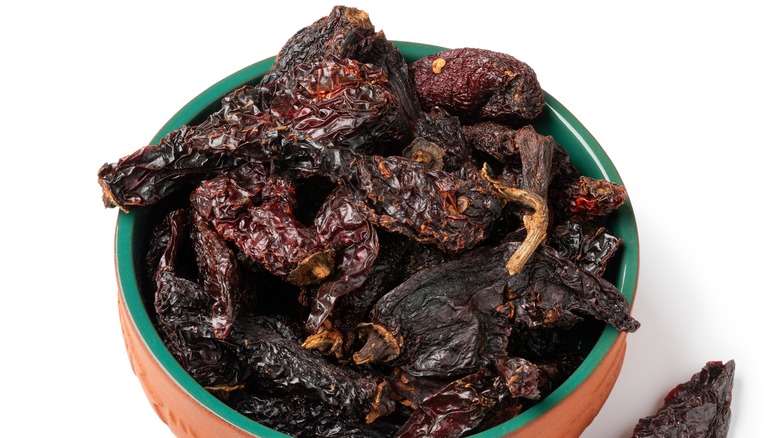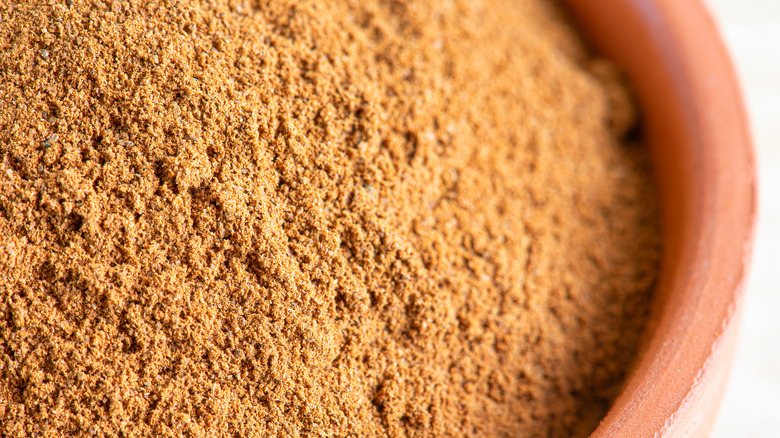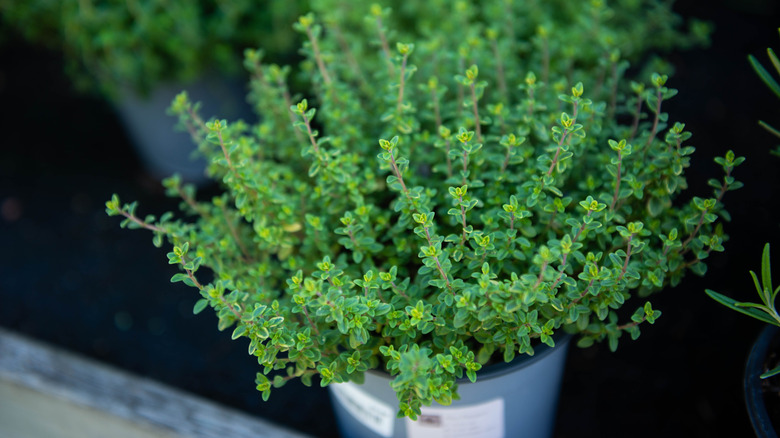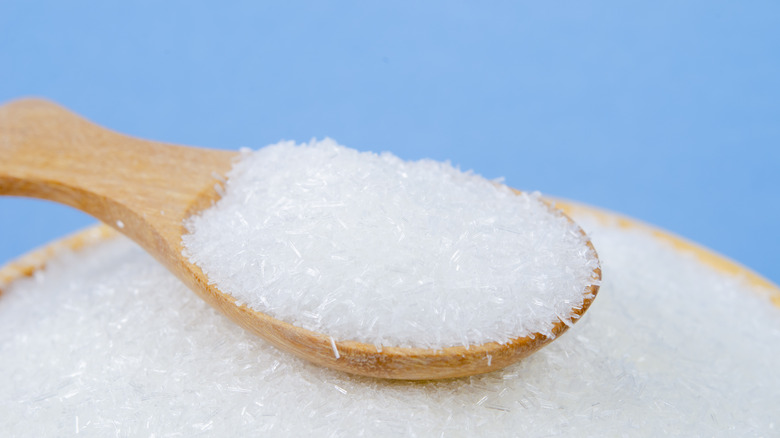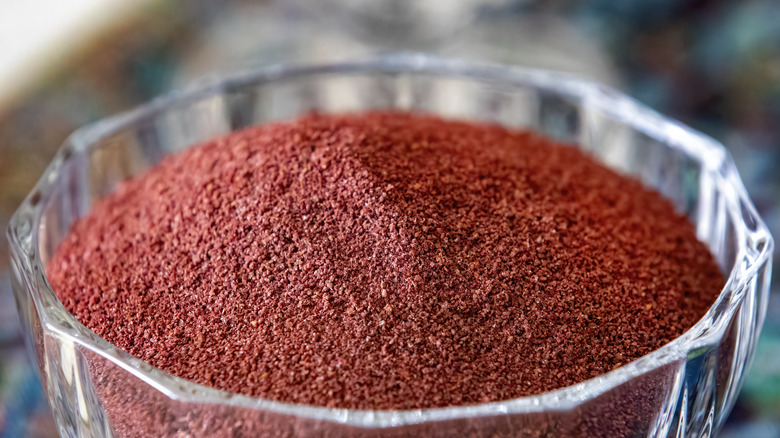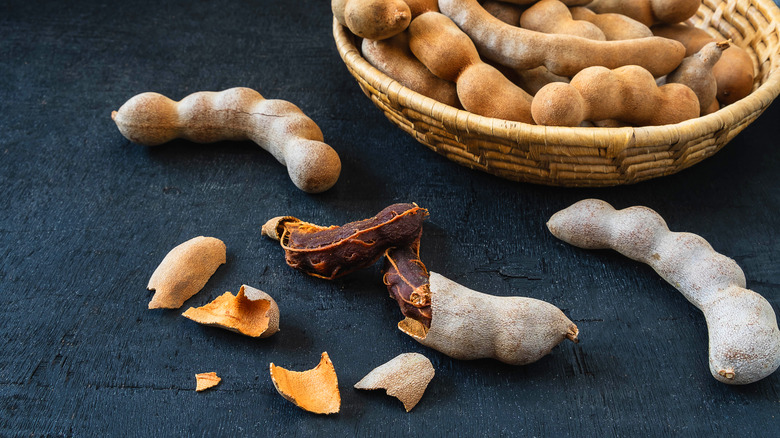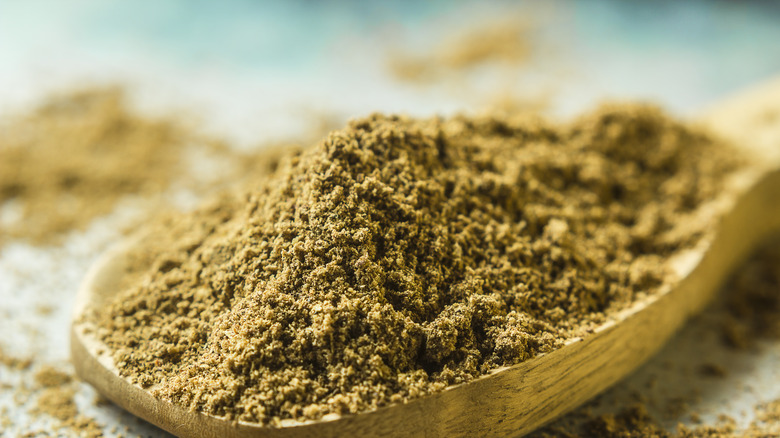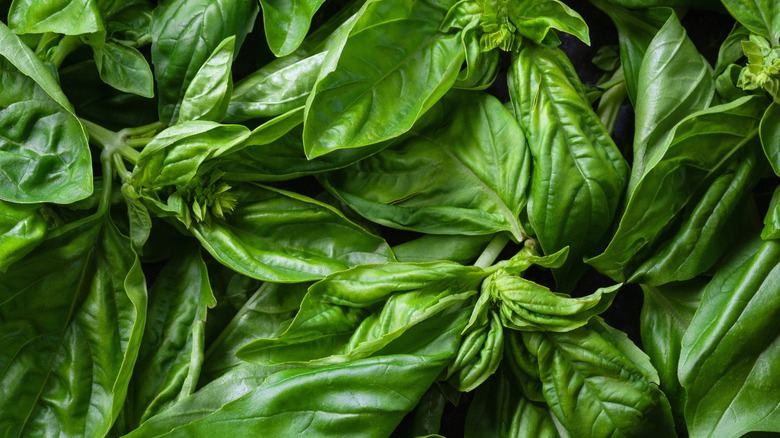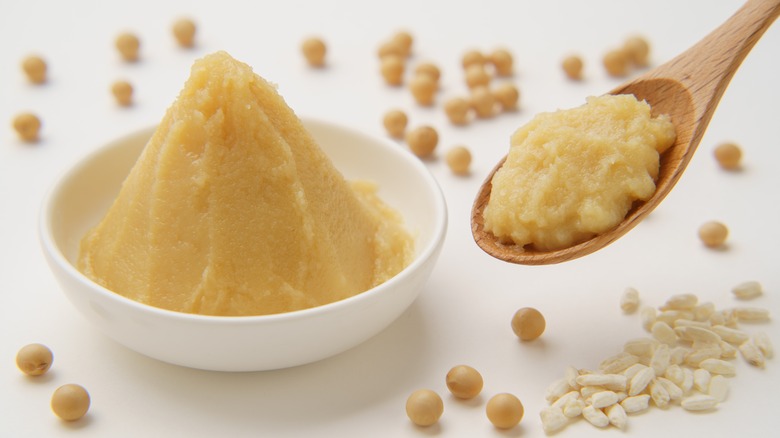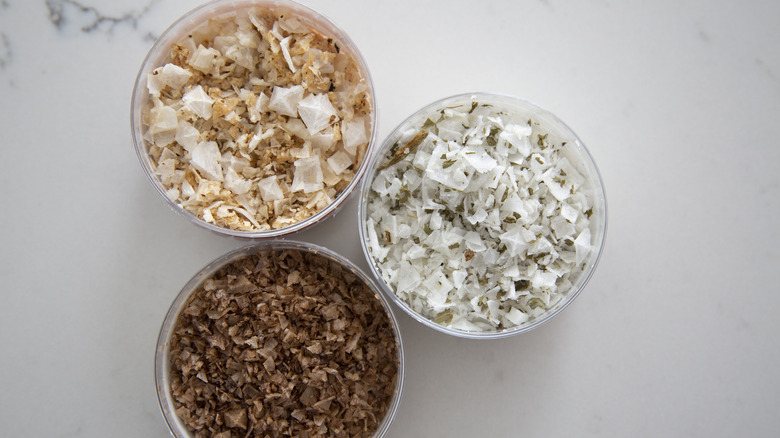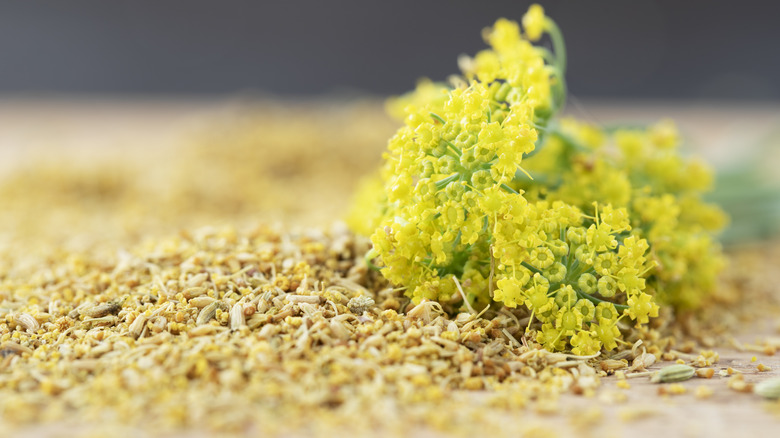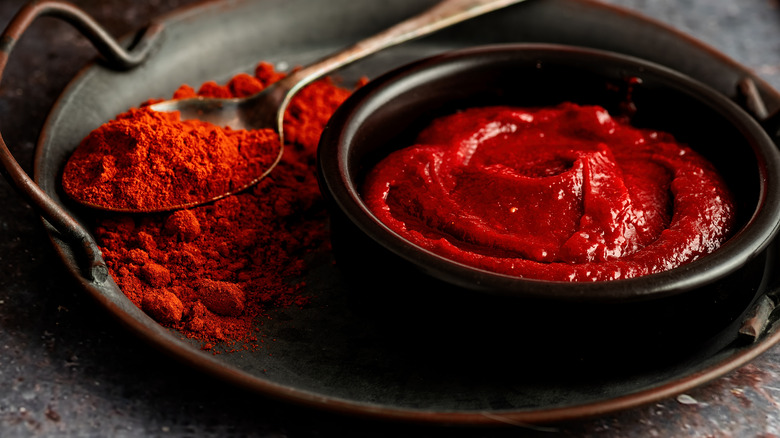15 Unexpected Seasonings You Should Start Adding To Desserts
When you think about the words "seasoning" and "dessert" in the same sentence, jars and containers of cinnamon, cloves, vanilla extract, and nutmeg may come to mind. While your spice cabinet is certainly a treasure trove for these classic baking ingredients, it's also home to many savory, spicy, umami, tart, and even bitter seasonings that deserve a place in your next dessert recipe just as much as the conventional ingredients.
As a home baker who admits to growing out of their sweet tooth (somewhat), I've grown more appreciative of the ways that these unconventional seasonings can add a unique dimension of flavor to my favorite recipes — from cookies and cakes to ice cream and pies. Not only do these seasonings introduce novel flavors, but they can also really highlight and elevate the other ingredients in the recipe. I've curated a list of some of my favorite herbs, spices, seasonings, and more that I think everyone should keep on hand and add to their desserts. All you need to start exploring them is a curious mind and even more curious taste buds.
Tarragon
There's no herb quite as multifaceted as tarragon. Not only is it the fresh ingredient that can upgrade your chicken salad, but it's also one that you should consider incorporating into your baked goods. It has some anise and licorice flavor properties with intermingled undertones of citrus and spice. It's a relatively tame way to get your foot in the door when it comes to baking with herbs, which is why I would recommend pairing it with so many different sweet items.
One great application for this herb would be in a panna cotta. Panna cotta is a dessert with a relatively neutral flavor, which will allow those anise notes in the herb to truly shine. You can simply place fresh herbs with your cream to let the flavors steep and impart into the fat before you proceed to cook with it. Similarly, tarragon would also be an excellent addition to churn into your homemade ice cream. I would recommend pairing it with other bright, juicy, and citrusy flavors, like lemon, orange, peach, or grapefruit. These fruits all have a citrusy flavor that will intertwine with those more prominent licorice notes in the herb.
Black pepper
There's a reason why almost every kitchen has black pepper in it. This spice will bite the tip of your tongue, but not leave you running for a glass of water to wash it all down. It's comparatively mild, especially when it's stacked up against some of the spicier peppercorns — which is why I love making desserts with it.
One of my favorite ways to use black pepper is as a flavoring in my pie crust. The small, black specks will provide the visual contrast that your basic flaky crust is looking for, along with a flavor that's unique but not unapproachable. A pumpkin pie would be a great match for pepper because the spice's sharpness would balance out the sweetness and density of the filling.
Although it might seem a bit odd of a duo, peppercorns are also a really great pairing for strawberries because the piquant flavor pairs well with the juicy, vibrant flavor of the berries. Try adding a few cranks of fresh black pepper to the base of your strawberry shortcake base and watch how it can highlight the juiciness of the fruit.
Soy sauce
Working with liquid seasonings comes with its challenges — that's for sure. Unlike herbs, which you can seamlessly stir into a pie crust or mix into the base of a cake, you have to be a little more careful when it comes to adding extra liquid to your recipe. Moreover, you also have to be mindful of how potent the flavor of that seasoning is in relation to the quantity that you're using.
Luckily, soy sauce is a pretty tame place to start. One of my favorite (not to mention one of the easiest) ways to incorporate soy sauce into your sweet recipe is to mix it into a wet caramel. Combine your soy sauce (which will replace the water traditionally used in wet caramel) and sugar in a saucepan. Once it's reached the perfect browning stage, you can then add in your heavy cream and give it a stir. This caramel can be an excellent addition to a plain vanilla ice cream because it has more depth than a traditional salted caramel, thanks to the soy sauce's slightly umami profile. Or, you can add it as a drizzle to cakes, cookies, or anywhere salted caramel sauce is used.
Chipotle
Chipotle peppers, how I love you so. While other types of chiles bring that piquant and disruptive heat, chipotle offers a more complex flavor that will elevate, but not distract, from the dish at hand. Whenever I've made desserts with chipotle, I often get an, "Oh! What is that?" from the folks who try it because the flavor is so layered and complex. Moreover, sweet, as a whole, is not something that chipotles inherently have, which is where you have opportunities to play with other ingredients.
Chipotle is an excellent pairing for chocolate, as it will further the cocoa's depth. For one, you can add this pepper to your next chocolate ganache by mixing together the ganache's two primary components — the chocolate and the cream — before adding in the dried chipotle powder. You may also want to try cayenne, which is a classic pairing with chocolate, or the smoky ancho chili for a little less ostentatious heat — but still a considerable amount of smoke flavor.
Chinese five-spice
I'm on a Chinese five-spice kick, and there's no stopping me. For the uninitiated, this spice blend is made with Sichuan peppercorns, cinnamon, cloves, fennel seeds, and star anise. It's punchy, bright, and really hits every single item on the flavor checklist that you could want it to hit.
Five-spice powder is predominately sweet, which makes it a fantastic addition to anything else that's sweet. For one, I love adding it to my apple pie crust; the cinnamon and the cloves really bring that traditional apple pie flavor, while the notes of the fennel seeds and the star anise drive home that slight complex bitterness and herbaceousness. The key here is that a little bit of this spice goes a long way, especially if your fruit filling already includes cinnamon and cloves. You could also experiment with other fruit pies, mainly pumpkin, but you won't want to use it for berry or citrus-forward pies because the five-spice powder will be easily obscured.
Thyme
Thyme is another easy spice to experiment with because it's relatively neutral in flavor. There are some minty notes there, but there's also a slightly peppery and sweet undertone to it as well. One of my favorite flavor pairings for it, as a whole, is anything citrus. Lemon meringue pies, lemon cheesecake, and lemon squares are all fair game when it comes to thyme. For one, you can add the fresh or dried herbs directly into your crumb or pie crust — or you can get more creative and find ways to add them to the lemon base instead. Or, use thyme as a tasty accompaniment to shortbread; it can easily shift the balance of this simple cookie to something slightly more savory than sweet.
Another way to add thyme to your desserts would be to infuse it into a whipped cream topping. Simply allow the herbs to steep in the cream overnight before you whip it into your topping. Berry cheesecake with thyme whipped cream would be the perfect springtime duo. Avoid heavy, dark flavors — like chocolate — that can obscure the gentle flavor of the herb.
MSG
MSG might seem like an ingredient out of left field — and rightfully so. This compound doesn't have flavor like conventional seasonings on this list, but it does bring one, highly-concentrated profile into fruition: the elusive umami. MSG is essentially the concentrated form of glutamate and is also often mixed with sodium to act as more of a two-in-one seasoning. However, MSG alone is not necessarily salty — and it does great work to highlight the other glutamate-containing ingredients in your recipe.
MSG is the unexpected secret to adding umami depth to a wide variety of desserts, but you have to use it carefully. It works best when it's mixed with other savory ingredients, like soy sauce, miso, or gochujang. But, there may be some less obvious pairings for MSG. For example, eggs and nuts are also naturally glutamate-rich. So, adding a little bit (emphasis on a little bit — no more than 1 teaspoon) of it to your next batch of egg tarts or pecan pie may be warranted.
Sumac
Sumac is a bit of an oddball of a seasoning. It's very floral and remarkably sour — which is not something that many home cooks are familiar with. It does best when paired with other Mediterranean flavors and ingredients — think ginger, walnuts, mint, allspice, and citrus. Since the flavor can be a bit overwhelming for most desserts, I would recommend using it in simple applications. For one, you could try adding it to a lemon cake base; Meyer lemon is much sweeter than the regular fruit and would help balance out the tartness of the sumac.
That being said, you could also pair your tart sumac with a competing spice, like chocolate. Dark chocolate, especially, has a bitter flavor, but it could use some tartness to balance it out and for a more well-rounded bite. A little sprinkling of sumac in a chocolate ganache would help bring some florality to it, along with a sourness to reduce its heaviness. Just be sure to also use sugar or some other sweetener to mitigate the sourness.
Tamarind
Tamarind is one that many people can probably admit they've never worked with — at least when it comes to desserts. But, chances are that you've probably eaten the pulp or concentrate in your takeout order of pad Thai — so it may not be all that unfamiliar.
The tamarind's flavor is a combination of sweet and sour, but I would say that it leans slightly more towards the latter end. That being said, tamarind is a great ingredient to balance out richer and heavier flavors. The paste or the concentrate would level up your next batch of caramel, or any dish that contains that sticky, syrupy sauce, like millionaire's shortbread. Or, consider adding a little bit of the paste to your next cake base. The slightly bittersweet flavor is a great complement to cinnamon, allspice, and star anise, which inherently makes tamarind an excellent addition to spice, carrot, or some other warm, autumnal sponge cakes.
Garam masala
Garam masala is a unique curry blend endemic to the South Asian countries like India, Bangladesh, and Sri Lanka. Its flavor is quite warm and inviting, and it walks a thin tightrope between being sweet and savory. Cinnamon, nutmeg, cardamom, and cloves all make an appearance in it, but you'll also find less conventional additions to desserts, like cumin, coriander, and black pepper.
In order to avoid cooking too much of the flavor off, you should avoid adding it too prematurely in the cooking process or hitting it with high heat for extended periods of time. For one, you may consider adding it to the topping of your next apple or peach crisp in place of traditional warming spices. The piquant hit of the pepper and the warmth of the cumin and coriander will make this dessert super unique. Or, pair it with root vegetables in a carrot cake or quick bread; like the crisp, you'll want to substitute out the warming spices for this blend instead.
Basil
Basil is a common ingredient for pesto, but why would it ever need to appear in a dessert? Like many other seasonings on this list, the flavor of this herb borders sweet and savory, and also incorporates some bitter and anise undertones as well. This herb is an excellent complement to berries — including raspberries, strawberries, and blueberries. For starters, try swapping out the tomatoes for strawberries in your summery caprese salad. The juicy and fresh strawberries would be not only an excellent complement to milky mozzarella but would also mesh well with a drizzle of balsamic and chopped basil. Or, you can make a basil whipped cream to use as a topping for your berry pie or crisp.
You could also add the dried herb to your shortbread cookies to give them a slightly savory profile. Besides berries, try playing with basil and stone fruits; think apricots, peaches, and nectarines. This herb represents all things summer and will bring a refreshing flavor to nearly everything you cook (or bake) with it.
Miso
If there is one seasoning that I'm most familiar cooking and baking with on this list, it would be miso. You can use miso paste for any of the dessert recipes where you would use salt. Start by adding it to baked goods to give them an umami edge. Chocolate chip cookies, which lean sweet, could be easily balanced by a little bit of miso paste in the dough. I love making a miso caramel and adding it to brownies or ice cream, too. The miso helps deflect from the overwhelming sweetness in the dessert and gives it more balance and dimension than standard table salt. That being said, since miso is quite salty, you'll need to cut back on the amount of other salty ingredients you use (which includes the salt you'd normally add to batters and dough).
The key to pairing miso with desserts is to give it the chance to shine. Don't try adding it to a basic sugar cookie or a delicate vanilla sponge, because you're bound to lose those light, unoffensive flavors with the drop-kick of the miso's umami and saltiness. Instead, match it with robust ingredients — like chocolate, stone fruit, caramel, and autumnal spices.
Smoked sea salt
Smoked sea salt is for when you want to start dipping your toes into the world of smoky and savory spices, but don't want to start playing with more powerful ingredients like liquid smoke. When baking or cooking with smoked sea salt, it's important to know that its flavor will dissipate the more that you cook it. It's why I prefer to use it as a finishing salt, rather than as a flavoring agent, in my dessert recipes.
Smoked sea salt, which comes in flavors like hickory, mesquite, and more, is a natural pairing for chocolate. You may consider adding a sprinkle of it to your next batch of brownies, on top of your chocolate chip cookies, or as a garnish for a thick and decadent chocolate frosting. The saltiness will draw attention to the sweet flavors in your recipe, while also bringing some straight-from-the-grill flavor. That being said, you might also add this salt to any dessert you would normally grill — like grilled peaches, watermelon, or pineapple. It will add that unique smokiness while still grounding itself in a briny, salty flavor.
Fennel pollen
You may have worked with fennel before, but it's less likely that you've tried your hand with the unique and wonderful seasoning known as fennel pollen. It's exclusively used as a finishing seasoning, and its light taste will be barely noticeable. But, if you close your eyes and concentrate, you can detect slightly sweet honey notes. If you tasted it on your finger, you would be able to detect some of those same anise and fennel flavors from the plant it's derived from, too — which means you still have to use it very deliberately and carefully in desserts.
Fennel pollen is a great pairing for nuts like almonds and pistachios, as well as apricots and other stone fruits. For one, you can try to make a simple olive oil pistachio cake topped with a balanced, sweet glaze and fennel pollen. It will remind you of the flavors of summer every time you make it.
Gochujang
Gochujang is complex, fiery, and one of the seasonings that I've grown to love. I liken it to a spicier version of miso; it has that same pasty consistency, but with a bright heat that will singe the tip of your tongue. As you can probably assume, you'll need to be mindful of this seasoning when you add it to delicately flavored desserts. I would also recommend adding it in moderation because too much can rapidly shift the balance of your recipe to something a little too hot.
Chocolate needs a bit of heat and can stand up to gochujang's profile remarkably well. Try making a gochujang Texas sheet cake; the paste is mixed into the icing, where it can be tempered by the sugar, but still offer a fresh mouthfeel. The fermented Korean chili paste can also be added to caramel in the same way that you would add miso; you may even want to try making spicy caramel cookies with it.
